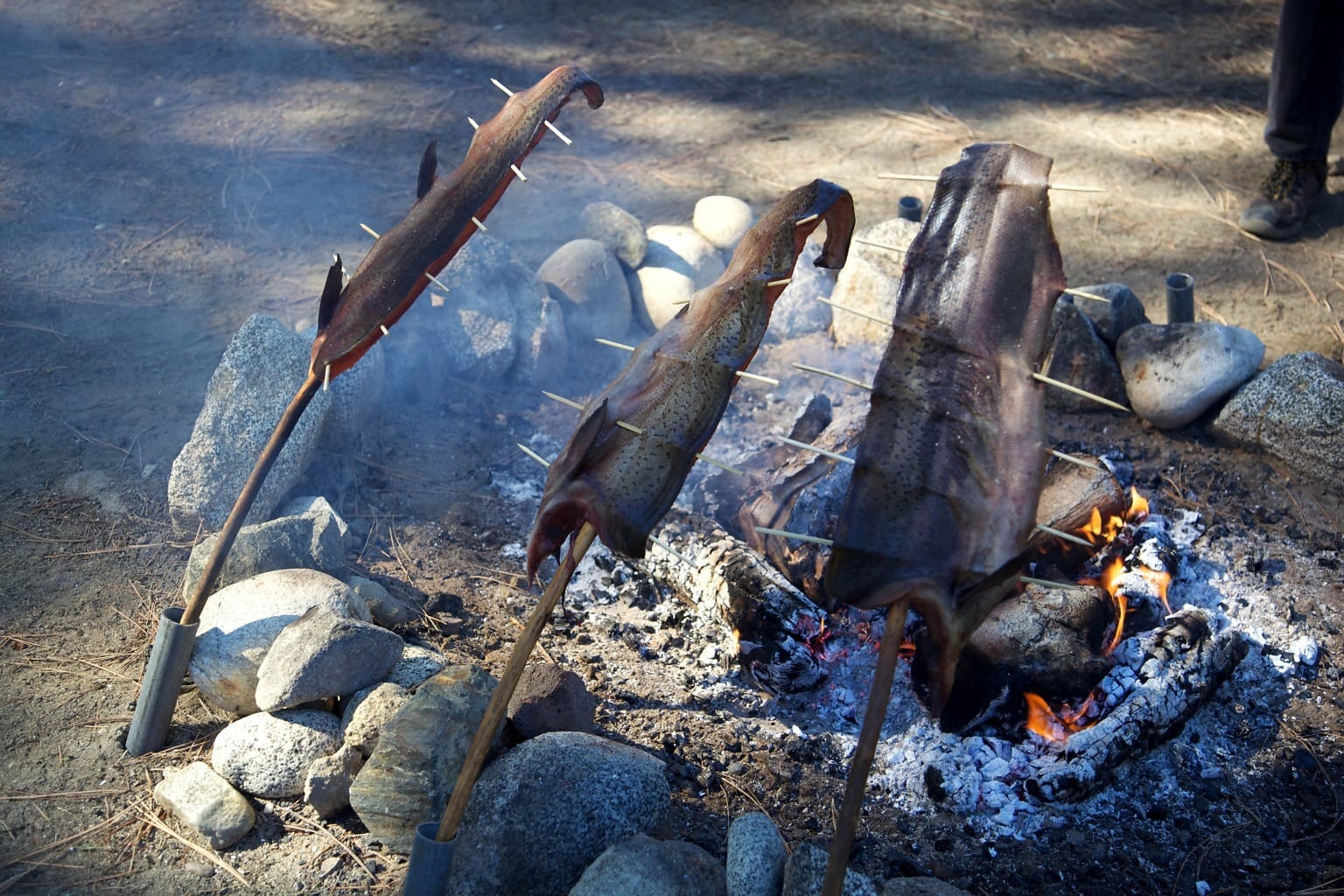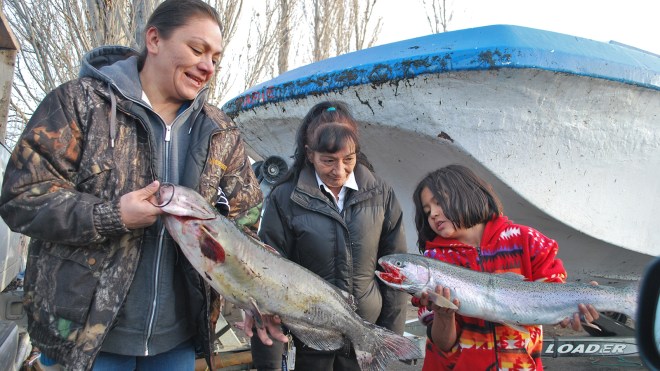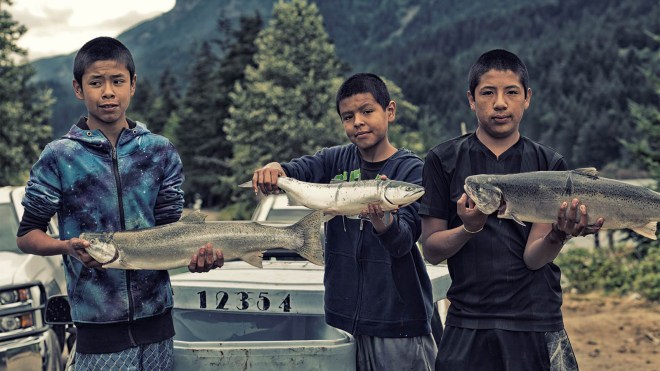Out in the middle of nowhere, people look out for one another. When you cut east along the Columbia River with “Sockeye” Suzy Lumley in the boonies of southern Washington, that fact stands out even more. If you come across her, don’t be surprised if she hands you some canned salmon.
As Lumley and I drove along the two-lane highway that winds along the Columbia’s banks in February, I learned that she sells fish by the crate. It was a clear day, and the hills were rolling. Then we flew by a small group of Yakama Native American women who were sitting on the side of the road. She slammed on the brakes and spun around her red Dodge Ram when she saw their bright dresses flapping in the wind. Lumley is also Yakama. They talked for a while, and then Lumley, who is only 4 feet 10 inches tall, climbed into the Ram’s bed and gave them a square flat of fish.
Lumley has enough to share. She runs a small business canning and selling Columbia River sockeye and other species. For the Yakama, Umatilla, Warm Springs, and Nez Perce Nations—the main groups that live out here—poverty is harsh and familiar. At the end of a long winter, especially, every can of fish helps.
Northwestern Native Americans have caught salmon from the Columbia River for thousands of years. Tribal fishermen now leave their reservations nine months out of the year and live in trailer camps that pop up every few miles along a 150-mile stretch of riverbank.
Bookended by two dams, these grounds form part of the border between Oregon and Washington State. For decades, Native fishermen got little more from the river’s bounty beyond their own subsistence. Natives were offered low prices for seafood because the way fish was usually handled and stored (basically throwing it in the back of a pickup truck or the stern of a boat) wasn’t up to commercial standards.
Thanks to Lumley and others’ work, that has changed over the past 10 years. Now, prices for Columbia River salmon have almost quadrupled, and you can find it on the menus of restaurants across the country with Michelin stars.
The higher prices paid for the Native catch have rippling economic benefits for indigenous communities. More members of tribes — younger ones, too — are heading to the river. Small businesses like Lumley’s can now hire new workers from outside the reservation and put in much-needed infrastructure. With the help of a government-funded program that brings Native American foods to people all over the world—a way of getting food to people that could be threatened by budget cuts made by the Trump administration—Lumbley is dreaming big about a bigger Columbia River fishery that helps everyone.
Salmon fishing was an integral part of life for many Native American tribes across the Pacific Northwest long before Europeans arrived in North America. From intricate weirs to dip nets, hooks and harpoons, various groups developed ingenious methods for catching the nutrient-dense fish that returned to regional rivers each year. While salmon was a dietary staple, it also held deep cultural significance.
Prominent Salmon Fishing Peoples
The peoples of the Pacific Northwest relied on salmon more than any other Native American groups. Here are some of the most notable:
-
Coast Salish: This cultural group stretched from Oregon to British Columbia along the coast. They engineered complex weir systems to trap salmon during spawning season.
-
Chinook: Based along the lower Columbia River, the Chinook were known for their large dugout canoes and fishing villages with wooden drying racks.
-
Tlingit: An Alaskan people, they built elaborate wooden fish traps and were renowned for their smoked salmon.
-
Hoh This small Washington State tribe was centered at the Hoh River and depended on its abundant salmon runs
-
Makah: Occupying the northwest tip of Washington, they hunted whales as well as salmon and were expert deep sea fishermen.
Ingenious Fishing Methods
Salmon was so critical to survival that tribes developed specialized techniques to catch the fish:
-
Dip nets Hand-held nets to scoop salmon from shallow water as they migrated upstream
-
Spears: Tipped with carved bone or antler points, these were thrusted at salmon.
-
Weirs: Complex systems of sticks and stones built across rivers to funnel salmon into traps.
-
Traps: Baskets or wooden traps were placed in weirs to collect fish during harvest time.
-
Hooks: Fashioned from shell, bone, wood, and later metal, hooks snagged salmon in open water.
-
Harpoons: Barbed spears thrown at salmon from boats or shoreline perches using spear-throwers.
Cultural Significance of Salmon
Beyond being an important food source, salmon held a deeper meaning for the cultures and belief systems of Pacific Northwest tribes:
-
The annual return of spawning salmon represented renewal, constancy, and the cyclical nature of life.
-
Salmon were considered a gift from the Creator and were treated with reverence.
-
First Salmon ceremonies were conducted as thanksgiving when the first fish arrived each spring.
-
Many groups believed they were spiritually related to salmon and shared the same essence.
-
Myths and legends featured salmon as central figures and explained their origins.
-
Fishing sites were often considered sacred spiritual places. Access was strictly managed.
-
Salmon fishing, processing, and feasting brought communities together socially.
Sustenance and Subsistence
Nutritionally, salmon provided sustenance for Native Americans in several ways:
-
Dried and smoked salmon lasted through the winter, ensuring a year-round food supply.
-
Salmon provided protein, healthy fats, vitamins, and nutrients to balance their largely plant-based diets.
-
Nearly all parts were used – flesh for food, oil for lamps, bones for tools. Nothing went to waste.
-
Abundant salmon runs supported larger, more settled communities.
-
Excess salmon was traded to interior tribes who did not have ready access to fish.
-
Feasting on the seasonal bounty of salmon helped tribes survive harsh winters.
-
Salmon returns were managed carefully to prevent overfishing and ensure future harvests.
Decline and Suppression of Traditions
In the late 1800s, commercial overfishing, habitat loss from mining and logging, and the damming of rivers began to threaten salmon populations and Native American fishing practices:
-
Dams blocked historical spawning routes and fishing sites were inundated by rising water.
-
Preserving traditional ways became difficult under pressures of assimilation.
-
Commercial fishing regulations restricted Native access to ancestral fishing areas.
Despite these challenges, the legacy of salmon in Pacific Northwest cultures endures through modern fishing rights activism, cultural revitalization, and the return of fish to rivers through conservation efforts. The historical reliance on the salmon’s abundance remains woven into the heritage of numerous Native peoples.

Building a better fishery
“Ice water is cold enough to hold your hand in,” JoLena Castilleja says as we walk along the smooth Columbia River. Wearing a knit cap and hunting jacket, she mimes placing a fish into an icy slurry.
Lumley’s oldest daughter, Castilleja, is 36 years old. She works in the family business as a fisherman with her brother, sister-in-law, three cousins, and stepfather.

When you add salt to ice water, the slurry’s temperature plummets, Castilleja explains. “There’s no holding your hand in,” she says, laughing.
Today, salmon that have just been caught are knocked over the head, their gills are bled, and they are then thrown into coolers of iced salt water. Extreme cold and blood-draining are important for high-quality meat because they keep it firm and add a week or two to the fish’s shelf life. Castilleja and a lot of other Native American fishermen learned how to do it in free classes on how to handle food put on by the non-profit Columbia River Inter-Tribal Fish Commission.
Roger Dick is a fisheries biologist from the Yakama Nation. He grew up in a fishing family and tells me that prices were much lower in the 1990s and early 2000s, before coolers like the ones Castilleja talks about became popular. Dick says that between $1 million and $2 million was once caught during the Yakama’s busiest salmon season, which ran from August to October. Today, it’s worth up to $6 million.
The new money is very important for Yakama fishermen, who usually spend the winter on the reservation, which is about an hour north of the Columbia River, using up all their savings until fishing season starts up again in the spring.
Substance abuse is pervasive on the reservation, where 43 percent of families live in poverty. (For comparison, the national rate was 13.5 percent in 2015.) In winter, the unemployment rate climbs to more than 70 percent, 14 times the national average.
People like Lumley are reinvesting the increased revenue from salmon fishing back into the community. She sources her fish from members of all four tribes. She has also hired and housed at least six Yakama teens on the Columbia for the past ten seasons, which has helped her business grow and kept the kids out of trouble.
People who buy fish and have known Lumley for 12 years say, “It turned some of these kids around.”

The higher prices are drawing more fishermen to the river and improving life back on the reservation. Dick says that families now have more money to keep the lights on during the winter, buy school clothes for their kids, and buy better, new fishing gear.
Of course, the fishing changes with the seasons and the moon. It depends on when the salmon runs in the section of the river that the tribes own and how many fish show up at that time. But while there’s some concern about scarcity year-to-year, overfishing isn’t a problem, according to Dick. Native Americans are strictly limited in the number of fish they can catch each season by state, federal, and tribal officials. These limits can be changed in the future to make sure salmon keep coming back.
Although ice has made Native-caught fish more competitive, it’s a scarce resource on the Columbia. Lumley typically buys ice in 10-pound bags from a little store near her camp. She has to drive at least 40 minutes one way to get more when the store runs out, which happens a lot.
Along the whole stretch of river, there is only one ice machine. It works in an empty warehouse an hour’s drive from Lumley’s camp. The building was put up more than ten years ago, and its original plan was for all four tribes to use as a place to smoke and process fish. But instead, according to Lumley, the groups are now bickering over financing and control of the project.
So Lumley is taking matters into her own hands. She plans to install a second ice machine near her family’s fishing camp. And she intends to fulfill the promise of building a processing plant on the river — a co-op that fishing crews from the four tribes can all use. Today, Lumley has to drive four hours into Oregon to have her catch smoked and processed. In 2015, one of the plants she worked with may have under-processed her fish, leading to a botulism scare and voluntary recall. Cutting out the middleman would give her more quality control in the future. It could also net dramatically better prices — on the order of five times higher for a single fish, she estimates.
Show that unity is a common goal. That’s her plan to avoid the fighting that left the processing plant almost empty. When Lumley gets more customers, she plans to buy from more local fishermen and pay them more money. She says that she is sure Native American fishermen will work together once they see that their pay is going up.
“It’s a way to get the prices up for the rest of the Natives,” Lumley says. “That’s my main goal. ”.
What Native American Tribes Were Eating In the Old West
How did Native Americans catch salmon?
Historically, Pacific salmon was the most abundant, and therefore most important food resource among coastal peoples and residents of major watersheds. In both spring and fall, salmon would travel up the rivers to spawn. Native people caught these fish using traps, nets, spears, and other highly specialized tools and techniques.
What kind of fish did Indians eat?
The Englishmen reported that the Indians caught a wide variety of fish including ” trout, porpoise, rayes, oldwives (probably menhaden), mullets, plaise (flounder), and very many other sorts of excellent good fish, which we have taken and eaten, whose names I know not but in the country language.”
How did Indians catch fish?
For the most part, the Indians caught their fish in net-like obstructions called weirs, which they placed across streams or channels in much the same way as modern pound-netters catch the seasonal runs of striped bass or shad. The weirs were made of reeds, woven or tied together, and anchored to the bottom by poles stuck into the sand.
Why were fishing and hunting important to the Native Americans?
Fishing and hunting were important activities for the Native Americans found living here by Sir Walter Ralegh’s explorers and colonists in the 1580s, for Indians relied heavily on the meat of wild animals and fowl, and on fish, for their food.
